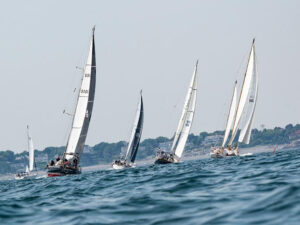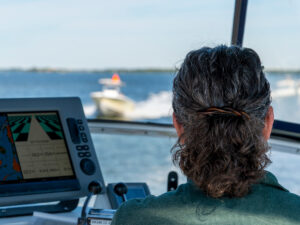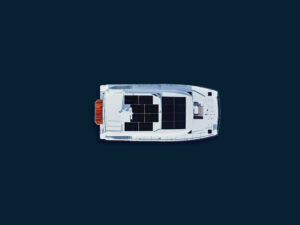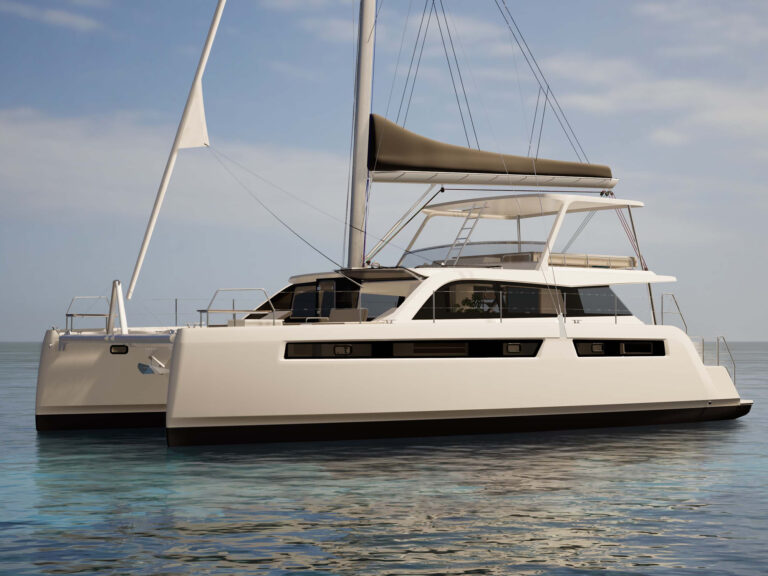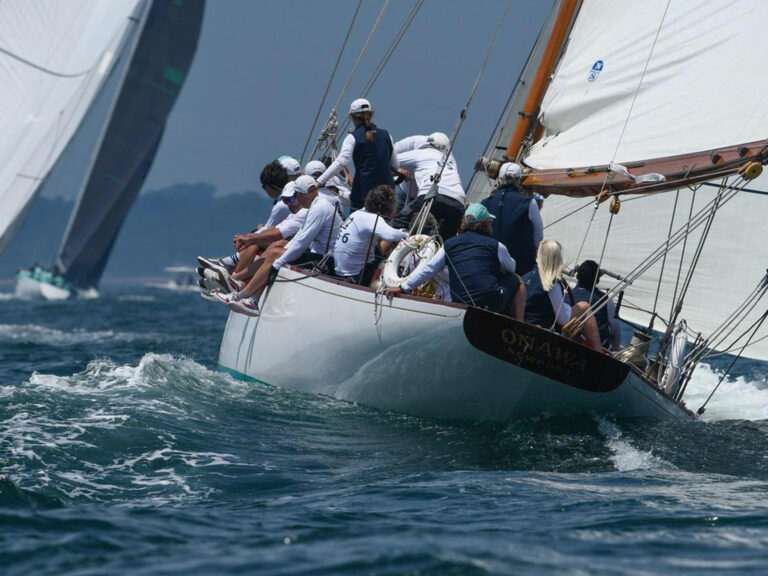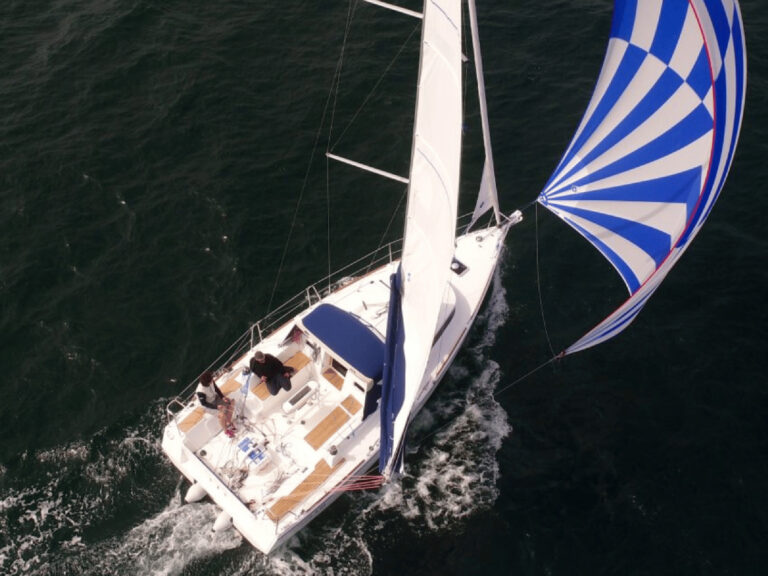
The Beneteau folks will tell you that their new flagship 54 was created with three features foremost in mind: the cockpit, the owner’s cabin, and the main saloon. In the course of our inspections last fall, Cruising World’s Boat of the Year judges discovered plenty of value in the boat’s many other features, as well.
From across the water, the 54’s sleekness is the thing you’ll notice first. On a waterline of almost 50 feet-the bow nearly plumb, the scoop transom canting gently aft from the deck-it’s the horizontal line that dominates. The cabin top scarcely rises off the foredeck before the mast, and no hard angles announce the house, only subtle curves. It’s a styling that serves livability, making the boat as easy to move around on as it is to look at. In fact, ease may very well be the boat’s dominant design theme: ease of living in port, ease of sailhandling while under way, ease of moving through the cockpit to the bow. A hinged transom opening leads forward from the swim step between twin wheels and into the cockpit. The cockpit settees, 70 inches long and shoulder-width deep, provide space for all but the tallest sailors to take their ease with an afternoon or off-watch nap.
The 54 is the top of the Beneteau line, which is designed by Berret Racoupeau. Nauta Design of Milan created the interior, whose tone is dominated by an attractive wood called Alpilignum (www.alpi.it) that’s made from stacking and gluing sheets of lumber, then slicing veneers from across the stack. The result is attractive, and the process fosters sustainable growth, something we were happy to see from a builder as prolific as Beneteau. As you step below, the boat’s 16-foot beam and panoramic fixed portlights in the deck provide an exemplary feeling of space and light. Through attentive architecture, the saloon escapes feeling too cavernous. I found that the arrangement of the galley countertop, the nav table, and the dinette seatbacks together provides ample support to grab or to plant a hip when the boat is under way. Of all the boats we sailed in the 2009 Boat of the Year contest, this boat’s cabins provided the best headroom for tall sailors. Shorter sailors may wish for one more step down from the companionway into the saloon; we measured 13 inches between steps-a bit of a stretch for some folks.
Tucked under the companionway and to port is a galley that’s at once spacious enough to cook elaborate meals and nicely integrated for sociability and traffic flow through the cabin: The cook is neither excluded from the fun nor forced to step out of anyone’s way. In an innovative move, the designers placed the sink just aft and outboard of the companionway ladder, with a drying rack tucked underneath. “The sink was near the centerline,” said BOTY judge Stacey Collins, “which was nice because it’s going to drain well on any tack.” She also noted a detail in the molded-resin countertops: “They had sort of a 1/8-inch lip routed out, which keeps water from sitting there and saves the wood joint from getting rotted and grungy.”
The berths in each of the cabins are fitted out not with mere foam cushions but with structured mattresses, something BOTY judge Ed Sherman commended. “I like that they used two mattresses, which simply made it easier to get to the equipment compartments.” He found the propeller-shaft seal under the aft berth difficult to access but the other engine-access points very accessible. The owner’s suite forward in the three-cabin layout we sailed features an island queen and a spacious head with separate stall shower; a four-cabin layout is also available. A separate quarters for crew, with a berth and a head, is accessed through a hatch in the foredeck.
BOTY judge Ralph Naranjo was impressed with the evolution of Beneteau’s engineering in this boat and others we sailed. “The signs of good engineering fall, for example, in the chainplate realm, where the tie-rods work well.” He was pleased, too, to see stainless-steel keel bolts and lead ballast, at a time when other high-volume builders are moving, seemingly backward, to mild steel and iron.
We sailed the Beneteau 54 in light conditions, which showed off the advantages of the boat’s low displacement-to-length ratio of 118. In scarcely more than 6 or 7 knots of breeze, we close-reached at a pleasant 4.2 knots. Under the power of a 110-horsepower Yanmar diesel at 2,600 rpm, we made 8.1 knots; at a fast-cruise rpm of 3,400, we made 8.6. “Boy, this boat really trucked along!” said Ed. The noise under power ranged from 92 to 94 decibels, placing it in the quietest third of this year’s fleet.
For all the boat’s volume, the Beneteau 54 proved a well-laid-out boat to sail shorthanded. Genoa-sheet winches are installed within easy reach of the twin helms, and the three or four steps from the helm to the cabin-top sail controls are uncluttered. The companionway itself features a sliding hatch and folding louvered doors, which may be fine for near-shore sailing; those who venture farther should add more seaworthy drop boards. The bridgedeck area leading to the companionway provides a comfortable “pit” to brace yourself in while you’re winching control lines.
The boat we sailed, hull number two, had a double anchor roller, but only one hawse hole for an anchor rode. Access to the chain locker was through the crew quarters, making it difficult for a single person to sort out hockles in the rode or twisted links in the chain. This was one case where we felt the designers’ emphasis on clean styling may have been taken one step too far; we would’ve preferred an opening into the anchor well from deck. On the plus side, the foredeck provides ample room to store a 10-foot dinghy on passage, something we were pleased to see.
All in all, after sailing and exploring the Beneteau 54’s interior, I’d say it stands worthy of its flagship title.
Tim Murphy is a CW editor at large. This article first appeared in the September 2009 issue of CW.
Specs
LOA 54′ 9″ (16.69 m.)
LWL 49′ 2″ (14.99 m.)
Beam 16′ 1″ (4.90 m.)
Draft 7′ 6″ or 5′ 11″ (2.29/1.80 m.)
Sail Area 1,329 sq. ft. (123.5 sq. m.)
Ballast 11,000 lb. (4,990 kg.)
Displacement 31,574 lb. (14,322 kg.)
Ballast/D 0.35
D/L 118
SA/D 21.3
Water 256 gal. (969 l.)
Fuel 125 gal. (473 l.)
Mast Height 75′ 5″ (22.99 m.)
Engine 110-hp. Yanmar diesel
Designer Berret Racoupeau and Nauta Design
Basic Sailaway Price $575,000
Beneteau USA
(843) 629-5300
To read more Cruising World reviews of Beneteau sailboats, click here. To visit Beneteau America’s website, click here.


